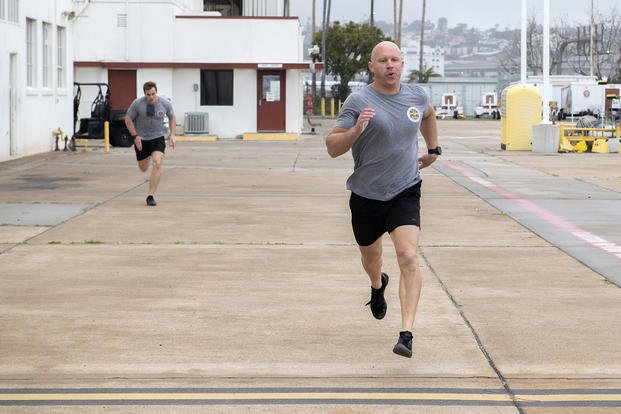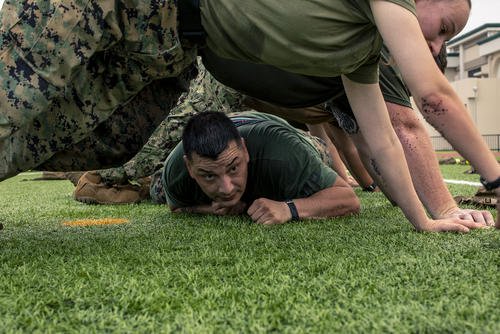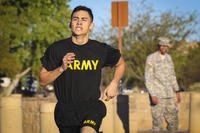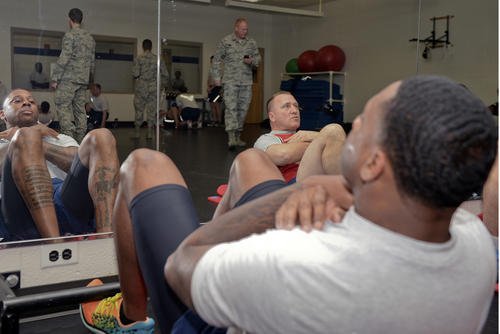The Coast Guard is changing its physical fitness assessments.
The service announced this week that all military personnel will be required to undergo mandatory physical fitness tests, or PFTs, beginning next year, Military.com reported. Those tests will be based on the existing boat crew fitness standards.
The boat crew test involves planks, push-ups and a 1.5-mile run. A 2,000-meter row or 12-minute swim can be done in place of the run, though, with time or distance requirements based on one’s age group.
While the events in this fitness test are not new to military testing, sit-ups have been replaced by the plank pose, and there are other aerobic test options available besides the 1.5-mile run. This also reflects the Navy’s most recent changes to the Physical Readiness Test.
Read Next: The Best Nutrition Tips Right Before a Military Fitness Test
This workout plan is designed to enhance your performance in three main areas of the PFT:
- The plank pose (core endurance)
- Push-ups (upper body strength and muscular endurance)
- Your choice of aerobic endurance event: 1.5-mile run, 2,000-meter row or 12-minute swim
The training ideas encompass specialized workouts that focus on individual events and mixed workouts that combine elements to maximize overall fitness and event-specific performance.
Individual Exercise Training Ideas
Improve Your Plank Pose
Use the plank pose as an active rest throughout your normal workout, which may include weight training, calisthenics or cardio events as an easy way to incorporate planking. This is an easy exercise at first, but after a minute, it can become a mental and physical challenge. Make sure you practice every other day for best results.
Standard plank: Three sets, hold as long as possible with perfect form. Rest 60 seconds between sets.
Plank with shoulder taps and leg lifts: Three sets of 20 taps (10 per shoulder, 10 single leg lifts each). Once you can hold the plank for a few minutes, try making it harder by doing the pose on one arm or leg.
Improve Your Push-Ups
Increasing your volume of push-ups will improve your push-ups but not too much. There is no need to do daily push-ups. Doing them every other day and progressively increasing the volume each week will help you prepare.
Push-up ladder: Use this as a progressive test each week to see how you perform. Start with one push-up, then rest for 10 seconds. Do two push-ups and rest 10 seconds; continue adding one rep per set until failure. Add 10 more seconds of rest every 3-5 sets as you increase the reps each set.
Push-up super set: Try this sub-max effort workout to build volume. Repeat 10-15 times:
- Push-ups: Do 25% of your current max (if you can do 40, then do 10 push-ups).
- After pushups, get into the plank pose for 30 seconds to one minute.
- Run or row for one minute (active rest).
If you have difficulty with push-ups, complete the set either on your knees or do negative push-ups by lowering yourself slowly to the ground for more than five seconds. Continue until you have completed the sets with the goal repetitions.
Improve Your Push-Ups and Plank with the Classic Combo
Try this Death by Push-ups workout once a week. It can be done before or after your cardio session or after an upper-body lifting workout that you enjoy doing. Here is how it works:
- Hold the plank pose for 5 minutes, but every minute on the minute (EMOM), do 10 push-ups.
That’s it! Build up to 10 minutes if you want to go hard-core. You can be in the plank pose or the “up” push-up position, but avoid the knees touching the ground for as long as you can.
Improve Your Time for the 1.5-Mile Running Test

Try three or four running workouts a week. Two should be interval training, not sprint/jog or sprint/walk but learning your goal pace. Do you want to run a six-minute mile pace (nine minutes for 1.5 miles)? A seven-minute mile pace (10:30 for 1.5 miles)? Or an eight-minute mile pace (12 minutes for 1.5-mile pace)?
Depending on your goals and current abilities, strive to achieve one of the paces and develop muscle memory so that running at that pace feels natural. Here are three workout options to progress with that focus on goal pace interval training:
- 6 x 400m at goal pace, rest 1 minute between intervals.
- 3 x 800m at goal pace, rest 2 minutes between intervals.
- 1 mile at an easy pace, 1 mile at a goal pace, 800 meters for an easy cooldown.
During the rest phase of the run, consider adding in push-ups and plank poses for a minute each to feel how you will be feeling on test day.
Do a longer, easier-paced run to build your aerobic base each week. Run 3 to 4 miles at a comfortable pace once per week. But if you feel like you are running too much, you can do this type of workout on a bike instead.
2,000-Meter Row Improvement
If you have access to a lake or rowing machine, I recommend practicing it several times a week before opting to “try it out” instead of running the test. This is harder than it looks and requires some technique in pulling and cardio conditioning specific to rowing.
- Interval rowing: 5 x 500 meters at goal pace, rest 2 minutes between intervals.
- Pyramid rowing: Row 250 meters, 500 meters, 1,000 meters, 500 meters and 250 meters; rest 1-2 minutes between each.
- Aerobic base rowing: Do 3,000 meters at a moderate pace for aerobic base building.
Here is a row and body-weight circuit. Repeat four times.
- 500-meter row at goal pace, then 20 push-ups, 1-minute plank.
- Rest 90 seconds.
- The finisher: Max push-ups, 1-minute and 2-minute plank pose.
12-Minute Swim for Max Distance Improvement
The goal of this test is to swim as many laps in the pool as you can in 12 minutes. A good goal is to maintain a pace of one yard per second, so shoot close to the 700- to 800-yard distance at an above-average training pace.
Here is a workout that will let you build up to that pace:
- 8 x 100 meters (100 seconds) at goal pace freestyle.
- Rest 10-15 seconds between intervals.
Endurance swim: a 20-minute continuous freestyle swim at a moderate pace.
Technique drills: Include 10 minutes of drills to focus on just the freestyle catch or kickboard to work on flutter-kicking more efficiently.
Repeat this swim set with plank and push-ups five times:
- 200-meter swim at goal pace, immediately followed by a 30-second plank hold and 10 to 20 push-ups on the pool deck.
- Start swimming again.
- Finisher: 5-minute swim at goal pace. Shoot for 300 yards (300 yards in 300 seconds).
By consistently following these specific and mixed workouts, you will develop the core strength, upper-body endurance and cardiovascular capacity necessary to enhance your plank pose, push-ups and performance in the 1.5-mile run, 2,000-meter row or 12-minute swim.
Adjust the plan to fit your schedule and choice of cardio events as desired, but consider mixing up the cardio options to work your conditioning without burning out on a single event. Adding a few nonimpact cardio events to your training routine, instead of running every day, can help prevent injury and make training less monotonous.
Related: Coast Guard to Launch Service-Wide Physical Fitness Test for All Members Next Year
Want to Learn More About Military Life?
Whether you're thinking of joining the military, looking for fitness and basic training tips, or keeping up with military life and benefits, Military.com has you covered. Subscribe to Military.com to have military news, updates and resources delivered directly to your inbox.


















